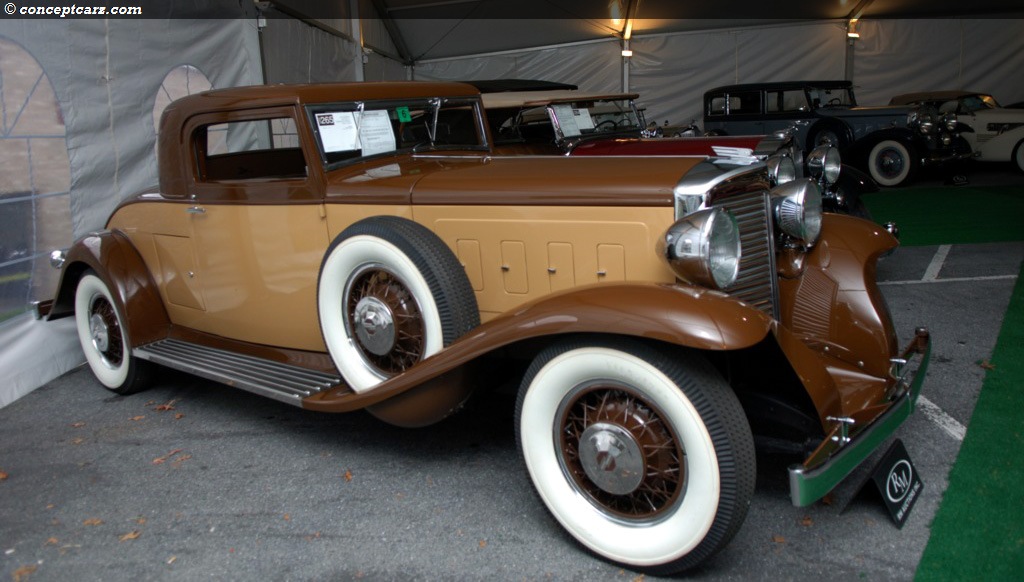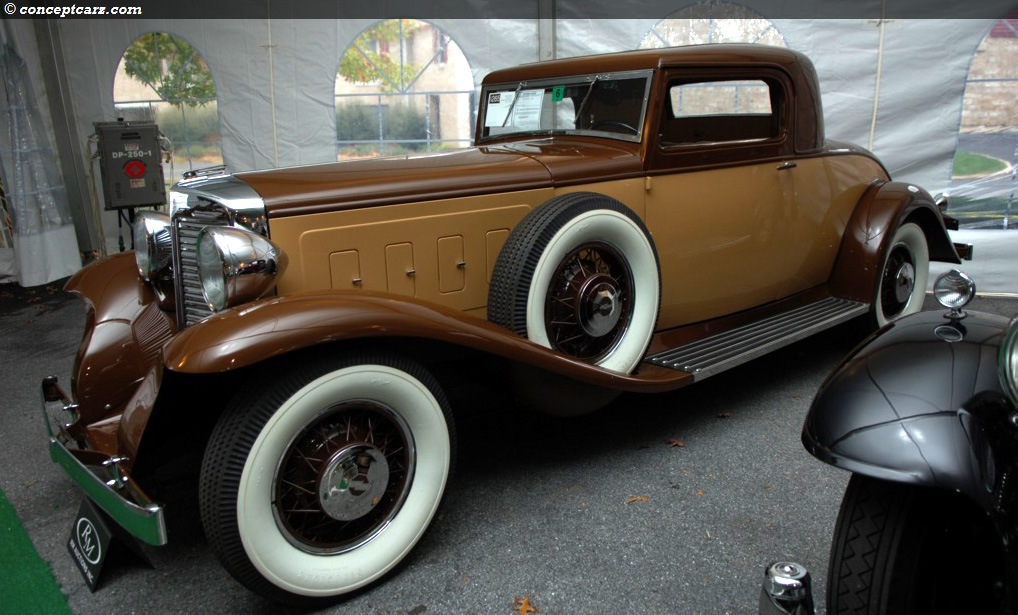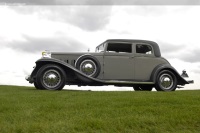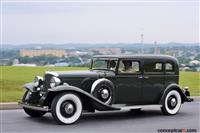Image credit: © conceptcarz.com (Reproduction Or reuse prohibited).

In 1902, at the tender age of just 23 years old, Howard Marmon proved his abilities as an engineer by completing his first automobile. It was a technically advanced vehicle at the time featuring overhead valves and air cooling. At the Indianapolis 500 just nine years later, Howard Marmon's long-tailed Marmon Wasp crossed the finish line in first position. It was the first car in history to ever cross the finish line and enter the winner's circle, as this was the inaugural running of the 500 at the Brickyard in 1911. Over the following two years, the Marmon vehicles would year more than 50 victories, many records, and a place in history as one of the early great racing marques.
Marmon excelled on the racing circuit, but in the production world, his cars were not as successful. His Model 49, based on the long-tailed Marmon Wasp, carried a price tag of $5,000 and found only a few interested buyers. In 1916 the Model 34 was introduced, bringing with it many new innovations and features, such as the extensive use of aluminum. Its radiator, transmission, rear axle, body, and fenders were created from this lightweight yet durable material. Sales were, again, slow.
During the First World War, Marmon aided the wartime effort by creating around 5,000 Liberty aircraft engines. After the War, the company was in good financial shape, and production of the Model 34 resumed. Sales remained slow, and soon came the economic post-war recession, which meant even more difficult times for Marmon. His brother resigned as president of the Company in 1924 and was replaced by George M. Williams. Williams's vision for the company was to make a more affordable automobile that could appeal to a wider audience of buyers. The result was the Roosevelt model, featuring a straight-eight engine, and became the basis for the company's revitalization in the years to come. As the 1920s came to a close, the company was creating more than 20,000 cars per year.
With strong sales and sufficient financial resources, Marmon turned his talents and attention back to creating mechanically advanced automobiles. Working on his own, Marmon introduced one of the most magnificent and brilliant vehicles of the classic era's in 1931, the Marmon Sixteen.
The Sixteen was powered by an engine that displaced nearly 500 cubic inches and fitted with state-of-the-art overhead valves. The car's effortless 100 mph speed was easily achieved thanks to the 200-horsepower all-aluminum engine and the lightweight components used throughout, including the aluminum chassis. It had a tremendous power-to-weight ratio and could outpace the Duesenberg Model J, while costing about one-third the price.
The problem with the Marmon Sixteen was its timing, introduced during the Great Depression and beaten to the market by the Cadillac V16. Marmon quickly went the way of so many other luxury car marques of the same era - it was forced to go out of business.
This 1932 Marmon Sixteen 2-4 Passenger Rumble Seat Coupe was offered for sale at the Vintage Motor Cars sale at Hershey, PA, presented by RM Auctions. It was estimated to sell for $200,000 - $250,000 and offered without reserve. It sold for $242,000, including the buyer's premium.
The bodies of the Marmon Sixteen were built by LeBaron with credit generally given to Walter Dorwin Teague Sr., though it was his son who sketched the lines and details. Walter Dorwin Teague Jr. was a student at MIT and a gifted designer. He designed a sleek and beautiful design that lacked gratuitous ornamentation which allowed the intrinsic beauty of the car's line and detail to be seen. The result was simple, yet undeniable elegance.
There were just 390 examples of the Sixteen created with 22 being the two-passenger coupes. Only six have survived to modern times, partly due to their aluminum bodies which tend to degrade quicker over time. The early portion of this vehicle's history is unknown; by the 1960s, it was part of the Harrah's Automobile collection in Reno, Nevada. In the early 1980s, it was acquired by an Arizona enthusiast who treated the car to a thorough restoration, including a full rebuild of the engine. In 1985 the car passed to another owner, who kept the car for many years before selling it to its current owner.
The car is painted chocolate brown with tan two-tone sides, an orange stripe, and tan Bedford Cord upholstery. It retains its original wire wheels and correct Marmon accessory chrome wheel discs.By Daniel Vaughan | Dec 2007
Marmon excelled on the racing circuit, but in the production world, his cars were not as successful. His Model 49, based on the long-tailed Marmon Wasp, carried a price tag of $5,000 and found only a few interested buyers. In 1916 the Model 34 was introduced, bringing with it many new innovations and features, such as the extensive use of aluminum. Its radiator, transmission, rear axle, body, and fenders were created from this lightweight yet durable material. Sales were, again, slow.
During the First World War, Marmon aided the wartime effort by creating around 5,000 Liberty aircraft engines. After the War, the company was in good financial shape, and production of the Model 34 resumed. Sales remained slow, and soon came the economic post-war recession, which meant even more difficult times for Marmon. His brother resigned as president of the Company in 1924 and was replaced by George M. Williams. Williams's vision for the company was to make a more affordable automobile that could appeal to a wider audience of buyers. The result was the Roosevelt model, featuring a straight-eight engine, and became the basis for the company's revitalization in the years to come. As the 1920s came to a close, the company was creating more than 20,000 cars per year.
With strong sales and sufficient financial resources, Marmon turned his talents and attention back to creating mechanically advanced automobiles. Working on his own, Marmon introduced one of the most magnificent and brilliant vehicles of the classic era's in 1931, the Marmon Sixteen.
The Sixteen was powered by an engine that displaced nearly 500 cubic inches and fitted with state-of-the-art overhead valves. The car's effortless 100 mph speed was easily achieved thanks to the 200-horsepower all-aluminum engine and the lightweight components used throughout, including the aluminum chassis. It had a tremendous power-to-weight ratio and could outpace the Duesenberg Model J, while costing about one-third the price.
The problem with the Marmon Sixteen was its timing, introduced during the Great Depression and beaten to the market by the Cadillac V16. Marmon quickly went the way of so many other luxury car marques of the same era - it was forced to go out of business.
This 1932 Marmon Sixteen 2-4 Passenger Rumble Seat Coupe was offered for sale at the Vintage Motor Cars sale at Hershey, PA, presented by RM Auctions. It was estimated to sell for $200,000 - $250,000 and offered without reserve. It sold for $242,000, including the buyer's premium.
The bodies of the Marmon Sixteen were built by LeBaron with credit generally given to Walter Dorwin Teague Sr., though it was his son who sketched the lines and details. Walter Dorwin Teague Jr. was a student at MIT and a gifted designer. He designed a sleek and beautiful design that lacked gratuitous ornamentation which allowed the intrinsic beauty of the car's line and detail to be seen. The result was simple, yet undeniable elegance.
There were just 390 examples of the Sixteen created with 22 being the two-passenger coupes. Only six have survived to modern times, partly due to their aluminum bodies which tend to degrade quicker over time. The early portion of this vehicle's history is unknown; by the 1960s, it was part of the Harrah's Automobile collection in Reno, Nevada. In the early 1980s, it was acquired by an Arizona enthusiast who treated the car to a thorough restoration, including a full rebuild of the engine. In 1985 the car passed to another owner, who kept the car for many years before selling it to its current owner.
The car is painted chocolate brown with tan two-tone sides, an orange stripe, and tan Bedford Cord upholstery. It retains its original wire wheels and correct Marmon accessory chrome wheel discs.By Daniel Vaughan | Dec 2007
2007 Vintage Motor Cars at Hershey
Pre-Auction Estimates :
USD $200,000-USD $250,000
Sale Price :
USD $242,000
1932 Marmon Sixteen Auction Sales
Recent Sales of the Marmon Sixteen
(Data based on Model Year 1932 sales)
| 1932 Marmon Sixteen Victoria Coupe Chassis#: 16-143-804 Sold for USD$280,000 2021 Gooding & Company : Pebble Beach Concours Auction |   |
| 1932 Marmon Sixteen Five-Passenger Sedan By LeBaron Chassis#: 16 140 818 Sold for USD$379,000 2021 RM Sothebys : Arizona | |
| 1932 Marmon Sixteen Two-Passenger Coupe by LeBaron Chassis#: 16 141 830 Sold for USD$665,000 2019 RM Sothebys : Scottsdale Arizona | |
| 1932 Marmon Sixteen Close-Coupled Sedan by LeBaron Chassis#: 16 149 802 Sold for USD$225,000 2018 RM Sothebys : Hershey |   |
| 1932 Marmon Sixteen Convertible Coupe by LeBaron Sold for USD$962,000 2017 RM Sotheby's : Icons | |
| 1932 Marmon V16 Victoria Coupe Chassis#: 16143718 Sold for USD$275,000 2014 Bonhams - The Scottsdale Auction |  |
| 1932 Marmon Sixteen Convertible Sedan Sold for USD$522,500 2012 RM - Milhous Collection, Fla | |
| 1932 Marmon Sixteen Sold for USD$242,000 2007 Vintage Motor Cars at Hershey |   |
| 1932 Marmon Sixteen Sold for USD$302,500 2007 Vintage Motor Car Auction at Meadow Brook Hall |   |
| 1932 Marmon Sixteen Convertible Sedan Chassis#: 16-145833 Sold for USD$473,000 2006 The Otis Chandler Collection Auction | |
| 1932 Marmon Sixteen Rumble Seat Conv. Coupe Chassis#: 144775 Sold for USD$247,500 2005 Vintage Motor Cars at Meadow Brook Hall | |
| 1932 Marmon Sixteen Victoria Coupe Chassis#: 16143767 Sold for USD$184,250 2004 Vintage Motor Cars at Meadow Brook Hall |   |
| 1932 Marmon Sixteen Rumble Seat Coupe Sold for USD$187,000 2003 Vintage Motor Cars at Meadow Brook Hall | |
| 1932 Marmon Sixteen Victoria Coupe Sold for USD$206,800 2003 JEM Museum Collection |
Marmon Sixteens That Failed To Sell At Auction
1932 Marmon Sixteen's that have appeared at auction but did not sell.
| Vehicle | Chassis | Event | High Bid | Est. Low | Est. High |
|---|---|---|---|---|---|
| 1932 Marmon Sixteen Victoria Coupe | 16143767 | 2022 Mecum : Monterey | $450,000 | ||
| 1932 Marmon V16 Victoria Coupe | 16143718 | 2013 Bonhams Quail Lodge Auction | $200,000 | $250,000 |
Vehicles With Comparable Market Values
Similar sales to the $367,968 range.
| 1947 Bentley Mark VI Cabriolet by Franay Chassis#:B26BH Sold for $370,940 2024 RM Sothebys : London |   |
| 1974 BMW 3.0 CSL 'Batmobile' Coupé Chassis#:4355031 Sold for $366,801 2024 Bonhams : The Zoute Sale | |
| 1993 Honda NSX Type-R Chassis#:NA1-1100077 Sold for $368,000 2024 Broad Arrow : Monterey | |
| 2001 Ferrari 550 Maranello Chassis#:ZFFZS49AX10123845 Sold for $368,000 2024 Gooding & Company : Pebble Beach | |
| 1959 Lister-Chevrolet Sports Racer Chassis#:BHL124 Sold for $368,000 2024 Gooding & Company : Pebble Beach |   |
| 1955 Chevrolet Bel Air Custom Convertible Chassis#:vc55t237110 Sold for $368,500 2024 Mecum : Indy | |
| 1981 BMW M1 Chassis#:WBS59910004301364 Sold for $368,944 2024 RM Sothebys : Monaco | |
| 2003 BMW Alpina Roadster V8 Chassis#:WBAEJ13413AH62341 Sold for $368,000 2024 Broad Arrow Auctions : Amelia |   |
| 2007 Honda NSX-R GT by 'Spoon' Chassis#:NA2-8000095 Sold for $368,000 2024 Bonhams : Amelia Island Auction | |
| 1932 Alfa Romeo 8C 2300 Monza Recreation by Pur Sang Chassis#:PS0327 Sold for $368,000 2024 RM Sothebys : Arizona | |
| 1975 Porsche 911 Carrera 2.7 MFI Chassis#:9115600109 Sold for $368,000 2023 RM Sothebys : The White Collection | |
| 2023 Aston Martin V12 Vantage Roadster Chassis#:SCFSMGBV4PGP07961 Sold for $368,720 2023 RM Sothebys : Munich | |
| 1967 Maserati Mistral 4.0 Spyder by Frua Chassis#:AM109/SA1 655 Sold for $368,234 2023 RM Sothebys : London | |
| 1942 Alfa Romeo 6C 2500 Roadster to Super Sport Specification Chassis#:915.163 Sold for $364,437 2023 Bonhams : The Zoute Sale | |
| 2022 PORSCHE 911 GT3 TOURING Chassis#:WP0AC2A93NS271246 Sold for $368,000 2023 Gooding & Company : Pebble Beach |  |
| 1921 STUTZ SERIES K BEARCAT Chassis#:10555 Sold for $368,000 2023 Gooding & Company : Pebble Beach |   |
| 1984 Ferrari 512 BBi Chassis#:ZFFJA09B000049473 Sold for $368,000 2023 RM Sothebys : Monterey |   |
| 1933 Rolls-Royce Phantom II Continental Drophead Coupe by Thrupp & Maberly Chassis#:3MW Sold for $368,000 2023 RM Sothebys : Monterey |   |
| 1993 Ferrari 512TR Chassis#:zfflg40a5p0095904 Sold for $368,500 2023 Mecum : 2023 Monterey | |
| 2016 Porsche 911 R Chassis#:WP0ZZZ99ZGS194561 Sold for $366,311 2023 RM Sothebys : The Carrera Collection |
1932 Marmon Sixteen
• Additional valuation insight and sales data• History
• Specifications
• Image gallery
• Other Marmon Sixteen model years



















